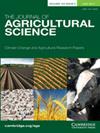香气化学物质的尖端技术鉴定及其对病原菌的作用
IF 1.7
4区 农林科学
Q2 AGRICULTURE, MULTIDISCIPLINARY
引用次数: 0
摘要
柑橘类水果及其精油在人类生活的各个方面都起着至关重要的作用。柑橘皮精油含有丰富的多酚类物质,是治疗多种疾病的次生代谢产物,可作为杀虫剂或农药使用。这些柑橘油衍生物在香精香料行业和快速消费品行业非常受欢迎。在目前的研究工作中,柑橘类水果有五个变种;选自印度不同地区的C. aurantium (Narinja)、C. hystrix (Gondhoajlebu)、C. limon (Lemon)、C. limetta (Mosambi)和Citrus reticulata Blanco (Nagur Orange);特伦甘纳邦、安得拉邦、加尔各答和马哈拉施特拉邦。利用SPME-GCMS分析进一步研究所收集的样品,以确定不常见的特定分子。通过GCMS分析鉴定出的分子主要有柠檬烯、α蒎烯、月桂烯、德尔塔-蒈烯、沙宾烯等。每个分子都有显著的香气,并在许多风味中使用。香水行业。在Narinja (C. aurantium)柑橘果实中鉴定出的化学分子是特异性的,在任何选定的水果中都没有鉴定出它们是双环绿烯、异戊二烯酮、α -桉树酚、β桉树酚。五种精油的抑菌活性研究报道:Narinja精油对大肠杆菌、金黄色葡萄球菌和芽孢杆菌的抑菌活性最强,其次是柠檬油和橙油对大肠杆菌和芽孢杆菌的抑菌活性,Mosambion芽孢杆菌和Gondhorajlebu对大肠杆菌的抑菌活性最强。这一数据表明,金菖蒲中有一些特殊的分子在药用方面值得进一步研究,可以作为驱蚊剂或在食品工业中应用。本文章由计算机程序翻译,如有差异,请以英文原文为准。
Aroma Chemicals Identification by Sophisticated Technique and Their Role Against Pathogens
Citrus fruits and their essential oils play a vital role in every aspect of human life. Essential oils derived from citrus peel are rich in polyphenols and act as secondary metabolites to treat various diseases and they can be used as insecticide or pesticide. These citrus oil derivatives are much popular in flavour and fragrance industry and FMCG sector. In present research work five variants of citrus fruits; C. aurantium (Narinja), C. hystrix (Gondhoajlebu), C. limon (Lemon), C. limetta (Mosambi) and Citrus reticulata Blanco (Nagur Orange) were selected from different regions of India; Telangana, Andhra Pradesh, Kolkata and Maharashtra. The collected samples were further studied using SPME-GCMS analysis to identify the specific molecules which are not in common. Most identified moleculesthrough GCMS analysis are Limonene, Alpha pinene, Myrcene, Delta-carene, Sabinene etc. Each molecule has a significant aroma and used in many Flavour & Fragrance industry. The chemical molecules identified in Narinja (C. aurantium) citrus fruit are specific and not identified in any of the selected fruits they areBicyclogermacrene, Isopiperitenone, Alpha eudesmol, Beta eudesmol. Antimicrobial activity of five essential oilsreports Narinja oil has potent activity on E. coli, Staphylococcus aureus and Bacillus followed by lemon oil and orange oil on E. coli and Bacillus, Mosambion Bacillus and Gondhorajlebu on E. coli. This data reveals that there aresome specific molecules in C. aurantiumto be considered for further research for their medicinal aspects, as mosquito repellent or in F&F industry.
求助全文
通过发布文献求助,成功后即可免费获取论文全文。
去求助
来源期刊

Journal of Agricultural Science
农林科学-农业综合
CiteScore
2.80
自引率
5.00%
发文量
68
审稿时长
1.4 months
期刊介绍:
The Journal of Agricultural Science publishes papers concerned with the advance of agriculture and the use of land resources throughout the world. It publishes original scientific work related to strategic and applied studies in all aspects of agricultural science and exploited species, as well as reviews of scientific topics of current agricultural relevance. Specific topics of interest include (but are not confined to): all aspects of crop and animal physiology, modelling of crop and animal systems, the scientific underpinning of agronomy and husbandry, animal welfare and behaviour, soil science, plant and animal product quality, plant and animal nutrition, engineering solutions, decision support systems, land use, environmental impacts of agriculture and forestry, impacts of climate change, rural biodiversity, experimental design and statistical analysis, and the application of new analytical and study methods (including genetic diversity and molecular biology approaches). The journal also publishes book reviews and letters. Occasional themed issues are published which have recently included centenary reviews, wheat papers and modelling animal systems.
 求助内容:
求助内容: 应助结果提醒方式:
应助结果提醒方式:


